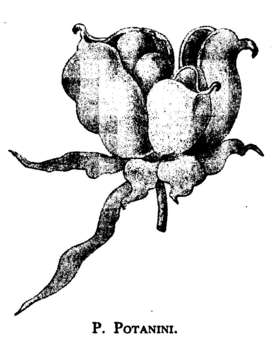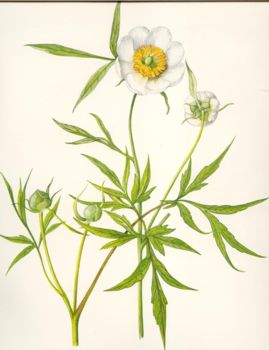accepted name (2005):
Paeonia delavayi
Basionym:
Paeonia delavayi var. alba Bean, Trees and Shrubs, 3, 265 (1933).
1946
Stern's original description:
Stern (1946):
5. Paeonia Potanini Komarov in Not. Syst. Herb. Hort. Bot. PetroP.2, 7 (1921) ; Schipczinsky, ibid. 47 (1921); F. C. Stern in Jown. Roy. Hort. Soc. 68, 1125 (1943).
Syn. P.Delavayi var. angustiloba Rehder & Wilson in Sargent, Plant. Wilson. 1, 318 (1913); Bailey, Stand. Cycl. Hort. 5, 2434 (1916) ; Rehder, Man. Cult. Trees and Shrubs, 215 (1927) ; Bean, Trees and Shrubs, 3, 265 (1933).
Description. A shrub up to about 1-5 m. high {fide Komarov), but 63-83 cm. high in cultivation in this country, stoloniferous and quite glabrous. Leaves biternate, but the leaflets so deeply and spreadingly dissected that they are difficult to classify, and the leaf may conveniently be described as ternate ; petiolule of middle primary division mostly 5-7 cm. (in cultivation up to 9 cm.) long, petiolule of lateral primary divisions i-a cm. (in cultivation up to 4-5 cm.) long ; petioles 11-12 cm. (in cultivation up to 15 cm.) long ; primary divisions 5-7,. pinnatipartite, the segments widely separated from one another and themselves pinnatipartite or lobed (the lower) or deeply pinnately-lobed to entire (the upper), segments and lobes oblong, tapering to the acuminate apex, mostly 5-10 mm. wide, up to 1.5-2 cm. wide only in the lower part of the less dissected upper segments. Flowers 5-6 cm. across. Bracts and sepals (forming a single series) 5-7 ; the outer 2 or 3 (rarely 4) oblong, acuminate, 2.5-5 cm. (in cultivation up to 7 cm.) long by 5.5-6 mm. wide, foliaceous; the remainder hemispherical to suborbicular and caudate or sharply cuspidate to rounded, 1-1.7 cm. in diameter, the innermost 2 or 3 somewhat pale green, often flushed with red, strongly concave. Petals deep maroon-red, obovate to broadly-obovate springing from a cuneate base, apex rounded or notched, margin slightly irregular, 2.5-3 by 1.5-2.2 cm. Stamens 1.3 to 1.5 cm. long, filaments red, anthers yellow. Carpels 2-3, glabrous, 1.2-1.3 cm. long, conical-flask-shaped, attenuated to the circinnate stigma. Disc produced as conspicuous fleshy lobes, up to 2-5 mm. high, round the base of the carpels. Follicles sometimes 1-5 but mostly 2-3 cm. long and very wide.

Distribution. china : western Szechwan, Tachien-lu district in Yalung valley, Potanin (fide Komarov) ; west of Tachien-lu descent to Yalung river, 3000-3600 m., Wilson Am, Arb. Exped. 1333 (K), same locality, Wilson Veitch ExP.3033 (K) ; Yunnan, hills around Yungning, 9500-10,000 ft., Forrest 12503 (E).
Paeonia Potanini differs from P.Delavayi in the absence of the conspicuous involucre typical of P.Delavayi and also in the narrower segments of the leaves, smaller flowers, paler colour of the stamens and in the manner of growth. It differs from P.lutea in having much narrower leaf segments, in its more erect growth and in the smaller flowers. The habit of growth of P.Potanini is stoloniferous and it spreads very fast in the garden. Komarov reports it as growing up to 1-5 m. high, which is much taller than any specimens I have seen. The report may be a mistake as it is not much more than half this height in cultivation.
Rehder and Wilson{I.e.} originally considered it to be a variety of P.Delavayi and named it P.Delavayi var. angustiloba, but Stapf regarded it as a species and named it P.angustiloba in MS. in the Kew Herbarium. I am in agreement with Stapf and consider it should retain its specific rank as it differs fundamentally from P.Delavayi in the absence of the conspicuous involucre. This being the case the name must be P.Potanini, the name given to it by Komarov.
Wilson collected this species in western Szechwan in 1904. It appears to have a restricted range spreading from the hills around Yungning in the south-west comer of Szechwan, on the border of Yunnan at about 10,000 ft., northwards near the Yalung river west of Tatsienlu in western Szechwan. [end page 048] Several forms are to be found in herbaria and also in the garden which vary in the size of the leaf-segments, some being very narrow indeed and some up to 2 cm. wide in the broadest part; variations also are shown in the flower colour, which range from maroon-red to bronze.
P.Potanini will grow in the garden in sun or shade and is not particular as to soil. It increases very fast by stolons and is suitable as an undershrub in the woodland garden, where it is handsome both in leaf and flower. It flowers in England at the end of May.
There is a white form of this species in cultivation which is described below.
P.Potanini forma alba F. C. Stern, forma nov. Syn. P. Delavayi var. alba Bean, Trees and Shrubs, 3, 265 (1933).
 P.Potanini
forma alba differs from the type in having white flowers,
in the filaments being green instead of pink and the stigma white
instead of reddish. In a letter dated May 12, 1923, Forrest
writes, "Probably the white-flowered plant is only a form,
for I remember being told of a white paeony having been seen on
the T'ong Shan, which lies east of the Lichiang range in lat. 27°
35', though I never managed to get specimens of it."
P.Potanini
forma alba differs from the type in having white flowers,
in the filaments being green instead of pink and the stigma white
instead of reddish. In a letter dated May 12, 1923, Forrest
writes, "Probably the white-flowered plant is only a form,
for I remember being told of a white paeony having been seen on
the T'ong Shan, which lies east of the Lichiang range in lat. 27°
35', though I never managed to get specimens of it."
The flowers of this form selfed with its own pollen have never set seed in my garden, but unprotected flowers have done so ; these gave rise to taller growing plants with small pink flowers, which looked like hybrids with P.Delavayi. They appeared to be intermediate between the two species in height, in the colour of the flowers and in the size of the leaves ; P.Delavayi was growing about 10 yards away. [end page 049]
Hong (1996):
Paeonia delavayi Franch., Bull. Soc. Bot. France 33: 382. 1886. TYPE: China. NW Yunnan: Lijiang (Likiang), Delavay 1142 (holotype, P; isotype, K).
.....Paeonia potaninii f. alba (Bean) Stern, Stud. Paeonia 49. 1946. TYPE: "t. 49 in Stern, Stud. Paeonia, 1946" (holotype).
Wang (1998):
P. potaninii Komarov forma alba (Bean) F.C.Stern, with white flowers. It grows in Yunnan.
Hashida (1995)

1999
HONG De-Yuan & PAN Kai-Yu Taxonomical history and revision of Paeonia sect. Moutan (Paeoniaceae) Acta Phytotaxonomica Sinica 37(4):351-368(1999)